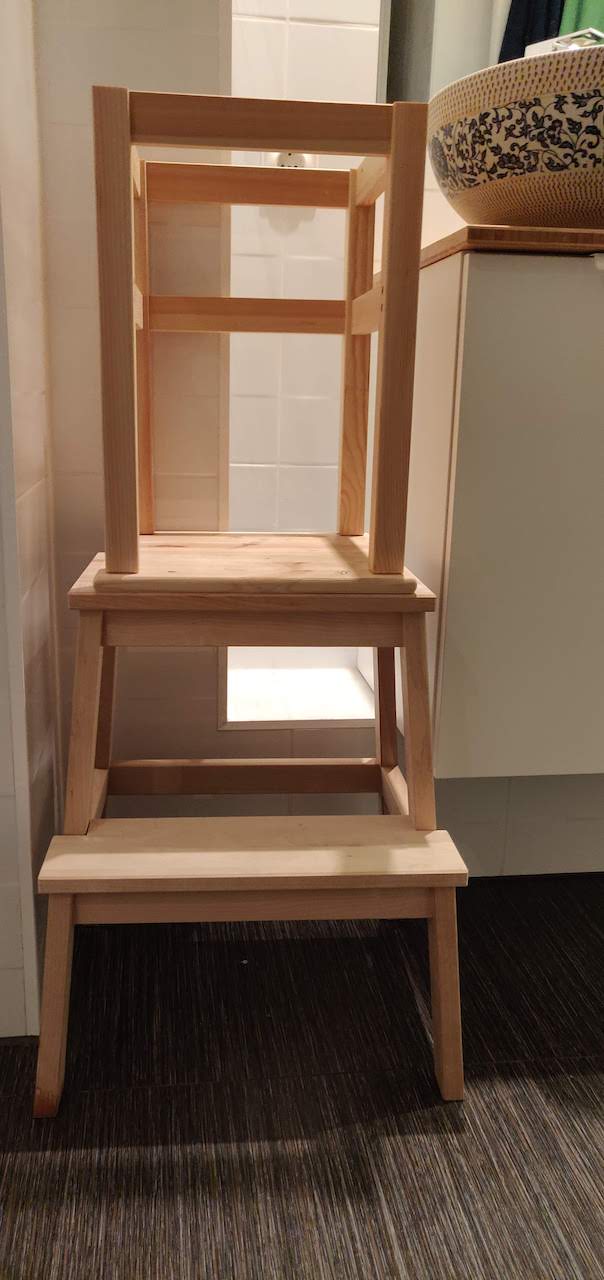I’m grateful to learn from my daughter. Be able to see how the brain develops and picks up new concepts, skills and words. Nowadays, I enjoy to sit down and watch her play. As a parent, I also need to help her to achieve her autonomy: emotionally, mentally and physically. It is the job, and my wife and I are navigating through it. There is not a guide on how to parent, and we discuss what is working and what is not working. Sometimes is just not the time for a new skill, other times our daughter doesn’t develop an interest for a particular activity. Well, we are all different, and that is what makes the world colourful!
Recently I was looking at one of the structures that we created to help our daughter to achieve her autonomy:

Yes, you are seeing it right, we have what so-called a learning tower, allowing kids to achieve higher heights. They can climb and reach the countertops, with a high degree of safety. This one is on our bathroom, and she uses it to help her with her morning routine.
What the heck is the relationship to organisational design?!
I can imagine that this is the question in your head. Well, I will continue to tell the story… We built the climbing towers after she started to walk without our help. My wife saw this concept in a parenting community, and we applied it. In the beginning, we asked our daughter if she wants to be in the climbing tower, and if she said yes, we would put her there. It was a “show and tell” type of style, given that it was a new concept to her. She used it for tasks such as brush her teeth, wash her hands, watch us cook, make a beverage. You can imagine the type of tasks.
What I observed across time, is that the brain embraced the concept, and when we nudge her for a task, let’s say, dinner, she would go to near the tower. It is a sign that she recognises the patterns, and knows the tools that can help her achieve the goal. Lately, she is proactive: we wake up in the morning, and she goes to the bathroom, climbs the tower and asks for her toothbrush. Most of the times, we don’t need to nudge her.
Applicability to organisations
With this story, I hope that I sparked your imagination. The bottom line is that as a manager, in a sociotechnical system, we should create structures that help people and teams to achieve their autonomy and agency. There is a wide range of practices, rituals and tools that can help, and all of them are context-dependent. To make it tangible, let’s say that you are a company with 375 people, and you are an online photo printing solution. The solution is in the cloud, and you take care of producing and deliver the photos worldwide. You have a diverse landscape, with custom software and standard hardware (printers). We rely on partners for the logistics operations, and you have a distributed workforce across the globe, to be close to the customers. You can picture other details… As director of software, you are responsible for the custom software that your customers are delighted for.
You can think about different practices, rituals and tools to help autonomy and agency within the company. Let’ explore some very concreate scenarios, which I hope you can relate with.
Onboarding of new colleagues
A new software engineer is hired. She will join one of the teams, and as part of the onboarding process, she has the starter pack, where she can find the information about the contact person for different operations. Information such as pension and salary declarations are requested to the HR department, vacations are booked in the internal portal, or the software development process can be consulted in the wiki. There is also a public schedule of the different rituals of the teams, such as demos.
The starter pack allows her to have an idea about the owners of different information and processes, allowing her to be autonomous. How many times did we move between jobs and at the same move between time houses? The real state agencies require a lot of paperwork, and most of it is provided by our employer.
Communities of practice
The company is growing, and the software was a monolith, managed by two teams, is now a distributed set of services. The services are loosely coupled and operated by 15 teams. As the complexity of the system increases, the teams adopted principles of observability, and they nail logging and metrics. However, they want to invest in tracing, to increase their capabilities, and streamline the development and operations processes.
As such, a community of practice was created. People from different teams come together, and work on common problems, with the end in mind. It allows space to co-create, diverge and converge, experiment, until patterns and practices start to emerge, and are useful to the different teams. Other community practices can exist and be in different areas. This is not a “or” exercise, is more like a “and” one.
Communities of practice enable agency of teams, where they can continue to align with the organisation purpose, but devise their own way to execute their mission.
A new service is added to the landscape
The company has leveraged cloud services for the last 7 years, but recently they started to move their services from infrastructure-as-a-service to cloud-native, where applicable. It has an impact on the services and the way they are bootstrapped and wired. The platform team created a few templates with different goals: on one side how to migrate the services when the paradigm changes, and on the other side if you do a new service what are the barebones to bootstrap the basics (authentication, authorisation, monitoring, etc.)
Having these templates, a team reduce their lead time to create a new service. The templates and documentation allow them to understand how things are wired and how cloud-native can be leveraged. Once again, the teams can maintain their agency, reducing the burned over the platform team for the creation of new services. Also, there is a change for evolution, as teams can contribute to the templates, co-evolving them as new insights are generated.
Organisations are complex sociotechnical systems
My goal with the examples is to provide some relatable scenarios, and I believe that stories are a great vehicle to convey a message. However, stories are context bounded, and the way that people or teams achieve something might not be feasible in a different context. Thus, my statement that ** organisations are complex sociotechnical systems**, and as a manager, we need to be aware of the complexity theory and how to navigate the inherent complexity.
I’m a student of complexity theory, and Cynefin, the work of Dave Snowden. Cynefin framework is a sense-making framework, allowing us to make sense of the world. I will not go into the details of Cynefin, this is not the goal of the blog post, nor I’m a specialist. I’m just a student.
My point is that you can use Cynefin to make sense of the different needs of your organisation and help people to set-up the additional structures to create agency and autonomy. A great story that exemplifies it is “Cultivating Leadership with Cynefin: from tool to mindset” from Jennifer Garvey-Berger, Carolyn Coughlin, Keith Johnston and Jim Wicks, in the book Cynefin, weaving sense-making unto the fabric of our world. In this story, they show us how an organisation grew, and what were the structures that they added to allow the autonomy of the consultants, allowing their consultancy practice to evolve – a prime example of a Teal organisation.
Sometimes organisational structures to create autonomy and agency are not used on the spot. You need to nudge the system, observe and reflect. Sometimes the concept is new, and people and teams are getting used to it, trying to find the applicability. Other times, the structure is useless, and if that is the case just discard it. As I wrote in the beginning, our daughter got used to the learning tower, and across time increased her autonomy.
I hope this sparked some ideas with you. What are the organisational structures that allow autonomy and agency in your company?
This blog was originally posted on João’s personal blog: Organisational structures to create autonomy: what I’ve learned from my daughter





